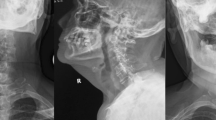Abstract
Objective
To elucidate the imaging manifestations of os odontoideum, establish the diagnosis and guide surgical therapy.
Methods
Clinical and imaging data, including X-ray, CT and MR of 24 patients with os odontoideum, were retrieved and reviewed retrospectively.
Results
Os odontoideum with intact cortex was divided into round, conical and blunt tooth types. Four cases of orthotopic and 20 cases of dystopic os odontoideum were included. There was anterior displacement of the base of the dens in six cases, posterior displacement in nine cases and no displacement in nine cases. A widening of anterior atlanto-axial space was shown in 14 patients with varying degrees. Thickening of the soft tissue posterior to the dens was observed in 19 patients, spinal canal stenosis in 21 patients, cervical myelopathy in 10 patients and craniocervical junction malformation in 9 patients. Posterior C1–C2 pedicle screw fixation and fusion was performed in 12 patients and 4 patients underwent posterior occipito-cervical fixation and fusion.
Conclusion
Radiographically, os odontoideum is defined as an independent ossicle of variable size with smooth circumferential cortical margins separated from the axis. Imaging can be used to assess atlanto-axial instability, associated normal or abnormal anatomical structures and guide surgical therapy.






Similar content being viewed by others
References
Akobo S, Rizk E, Loukas M et al (2015) The odontoid process: a comprehensive review of its anatomy, embryology, and variations. Childs Nerv Syst 31:2025–2034. https://doi.org/10.1007/s00381-015-2866-4
Arvin B, Fournier-Gosselin MP, Fehlings MG (2010) Os odontoideum: etiology and surgical management. Neurosurgery 66:22–31. https://doi.org/10.1227/01.NEU.0000366113.15248.07
Chatterjee S, Karmakar PS, Mitra R et al (2013) Sudden onset quadriparesis after minor injury to neck in a male with os odontoideum. J Assoc Physicians India 61:138–139
Choit RL, Jamieson DH, Reilly CW (2005) Os odontoideum: a significant radiographic finding. Pediatr Radiol 35:803–807. https://doi.org/10.1007/s00247-005-1448-0
Currarino G (2002) Segmentation defect in the midodontoid process and its possible relationship to the congenital type of os odontoideum. Pediatr Radiol 32:34–40. https://doi.org/10.1007/s00247-001-0579-1
Dias RP, Buchanan CR, Thomas N et al (2016) Os odontoideum in Wolcott-Rallison syndrome: a case series of 4 patients. Orphanet J Rare Dis 1:1–5. https://doi.org/10.1186/s13023-016-0397-z
Giacomini C (1886) Sull’esistenza dell’“os odontoideum”nell’uomo. Gior Accad MedTorino 49:24–28
Johal J, Loukas M, Fisahn C et al (2016) Bergmann’s ossicle (ossiculum terminale persistens): a brief review and differentiation from other findings of the odontoid process. Childs Nerv Syst 32:1603–1606. https://doi.org/10.1007/s00381-016-3199-7
Jumah F, Alkhdour S, Mansour S et al (2017) Os odontoideum: a comprehensive clinical and surgical review. Cureus 9:1551.e1–1551.e8. https://doi.org/10.7759/cureus.1551
Jun BY (1999) Complete reduction of retro-odontoid soft tissue mass in os odontoideum following the posterior C1–C2 transarticular screw fixation. Spine 24:1961–1964. https://doi.org/10.1097/00007632-199909150-00017
Kanai M, Kijima K, Shirahata E et al (2005) Odontoid compression of the brainstem without basilar impression—“odontoid invagination”. J Clin Neurosci 12:565–569. https://doi.org/10.1016/j.jocn.2004.07.022
Kim TY, Ratnayake K (2017) Os odontoideum discovered after minor cervical trauma. Pediatr Emerg Care 33:104–106. https://doi.org/10.1097/PEC.0000000000000945
Klimo P Jr, Coon V, Brockmeyer D (2011) Incidental os odontoideum: current management strategies. Neurosurg Focus 31:246–247. https://doi.org/10.3171/2011.9.FOCUS11227
Korres DS, Chytas DG, Markatos KN et al (2017) The “challenging” fractures of the odontoid process: a review of the classification schemes. Eur J Orthop Surg Traumatol 127:469–475. https://doi.org/10.1007/s00590-016-1895-3
Montemurro N, Perrini P, Mangini V et al (2019) The Y-shaped trabecular bone structure in the odontoid process of the axis: a CT scan study in 54 healthy subjects and biomechanical considerations. J Neurosurg Spine 1:1–8. https://doi.org/10.3171/2018.9.SPINE18396
Nguyen JC, Pollock AN (2015) Os odontoideum. Pediatr Emerg Care 31:225–227. https://doi.org/10.1097/PEC.0000000000000411
Perrini P, Montemurro N, Iannelli A (2013) The contribution of Carlo Giacomini (1840–1898): the Limbus Giacomini and beyond. Neurosurgery 72:475–481. https://doi.org/10.1227/NEU.0b013e31827fcda3
Sankar WN, Wills BP, Dormans JP et al (2006) Os odontoideum revisited: the case for a multifactorial etiology. Spine 31:979–984. https://doi.org/10.1097/01.brs.0000214935.70868.1c
Sardi JP, Iwanaga J, Oskouian RJ et al (2017) First gross anatomic findings of an os odontoideum. World Neurosurg 101:813.e1–813.e3. https://doi.org/10.1016/j.wneu.2017.03.066
Spierings EL, Braakman R (1982) The management of os odontoideum. Analysis of 37 cases. J Bone Jt Surg Br 64:422–428. https://doi.org/10.1097/01.brs.0000214935.70868.1c
Wang S, Wang C (2011) Familial dystopic os odontoideum. J Bone Jt Surg Am 93A:893. https://doi.org/10.2106/JBJS.J.01018
Zhang Z, Wang H, Chao L (2014) Acute traumatic cervical cord injury in pediatric patients with os odontoideum: a series of 6 patients. World Neurosurg 83:1180.e1–1180.e6. https://doi.org/10.1016/j.wneu.2014.12.036
Zhang Z, Zhou Y, Wang J et al (2010) Acute traumatic cervical cord injury in patients with os odontoideum. J Clin Neurosci 17:1289–1293. https://doi.org/10.1016/j.jocn.2010.01.051
Author information
Authors and Affiliations
Contributions
QW: data collection, data analysis, manuscript writing and editing. SD: data collection, manuscript writing and editing. FW: protocol and project development, data collection, data analysis, manuscript writing and editing.
Corresponding author
Ethics declarations
Conflict of interest
The authors declare that they have no conflict of interest.
Additional information
Publisher's Note
Springer Nature remains neutral with regard to jurisdictional claims in published maps and institutional affiliations.
Rights and permissions
About this article
Cite this article
Wang, Q., Dong, S. & Wang, F. Os odontoideum: diagnosis and role of imaging. Surg Radiol Anat 42, 155–160 (2020). https://doi.org/10.1007/s00276-019-02351-3
Received:
Accepted:
Published:
Issue Date:
DOI: https://doi.org/10.1007/s00276-019-02351-3




